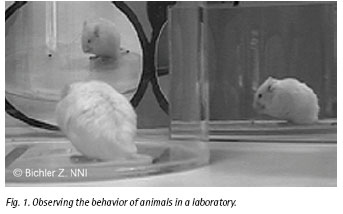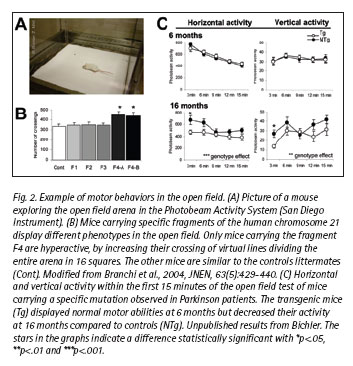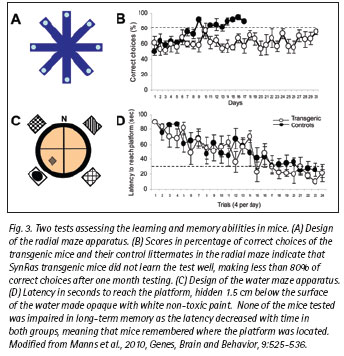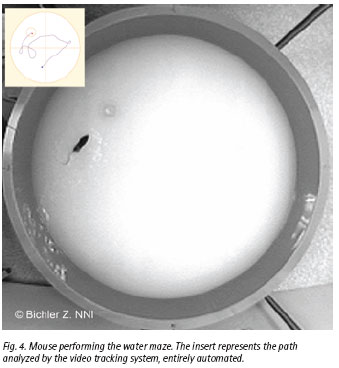|
by Zoë Bichler
 sychiatric and neurodegenerative disorders are widespread disorders. In developed countries, 25% of adults suffer serious mental disorders, and more than 10% of the population over 65 years develop Alzheimer or Parkinson's disease. In Singapore, Parkinson's disease is the most common neurodegenerative disease seen at the outpatients’ clinics of the National Neuroscience Institute (NNI), affecting 1 to 2% of people above the age of 65. Ageing and environmental factors such as stress are the most important causes of psychiatric and neurodegenerative diseases and as the population is getting older, the number of new cases will increase accordingly. The current treatments are most of time only palliative and their success depends on the reactivity of each patient, his life history and genetic background. The social and economical implications are huge, and it is urgent to find new therapeutic strategies to address these disorders. The research for optimal medical treatments is however very limited in humans, as only few invasive studies are possible. That is why animal models have been a cornerstone for making progress and developing new therapeutic strategies. sychiatric and neurodegenerative disorders are widespread disorders. In developed countries, 25% of adults suffer serious mental disorders, and more than 10% of the population over 65 years develop Alzheimer or Parkinson's disease. In Singapore, Parkinson's disease is the most common neurodegenerative disease seen at the outpatients’ clinics of the National Neuroscience Institute (NNI), affecting 1 to 2% of people above the age of 65. Ageing and environmental factors such as stress are the most important causes of psychiatric and neurodegenerative diseases and as the population is getting older, the number of new cases will increase accordingly. The current treatments are most of time only palliative and their success depends on the reactivity of each patient, his life history and genetic background. The social and economical implications are huge, and it is urgent to find new therapeutic strategies to address these disorders. The research for optimal medical treatments is however very limited in humans, as only few invasive studies are possible. That is why animal models have been a cornerstone for making progress and developing new therapeutic strategies.
Animal models are widely used in scientific research. They have played a role in almost all the major medical advances of the last century, including the discovery of penicillin and antibiotics, immunization against polio, diphtheria and other common diseases, insulin treatment for diabetes, blood transfusion, transplantations, and surgery for Parkinson's disease. Rodents — mouse and rats — are the animal of choice for the modern medical research. They share a high degree of genetic homology and similar physiological functions with humans, and have a naturally short life span, that allows investigating long term pathological changes. Some diseases appear spontaneously, like seizures, retinal degeneration, immunological dysfunctions, or tumors, though the disease must be most of the time induced by toxins, bacteria, virus, surgery, or genetic modification.
Measuring the Behavior of Animals
 While the physiological interest in animals exists since centuries, testing animal behavior in view of the modern neuroethological approach begun only in the 1950s, being nowadays an entire part of the biomedical and scientific research. Combined with genetic and molecular approaches, neurobehavioral sciences give hope for unraveling new medical challenges, such as the understanding of the mechanism of our memory. For example, it has been recently shown for the first time how individual mouse brain cells were activated during memory recall in a test associating an unfamiliar odour with a mild electric shock. Neurobehavioral studies also help to identify and understand the role of genes in neurological diseases: mice bearing the three common mutations seen in Alzheimer patients-namely the PS1(M146V), Swedish mutation of APP, and tau(P301L) transgenes — mimic many critical hallmarks of the disease. They show cognitive deficits and other behavioral alterations at ages before neuropathology is recognized. This kind of work helps to understand how the disease evolves and is of great interest to develop therapeutic strategies at all stages of the disease. While the physiological interest in animals exists since centuries, testing animal behavior in view of the modern neuroethological approach begun only in the 1950s, being nowadays an entire part of the biomedical and scientific research. Combined with genetic and molecular approaches, neurobehavioral sciences give hope for unraveling new medical challenges, such as the understanding of the mechanism of our memory. For example, it has been recently shown for the first time how individual mouse brain cells were activated during memory recall in a test associating an unfamiliar odour with a mild electric shock. Neurobehavioral studies also help to identify and understand the role of genes in neurological diseases: mice bearing the three common mutations seen in Alzheimer patients-namely the PS1(M146V), Swedish mutation of APP, and tau(P301L) transgenes — mimic many critical hallmarks of the disease. They show cognitive deficits and other behavioral alterations at ages before neuropathology is recognized. This kind of work helps to understand how the disease evolves and is of great interest to develop therapeutic strategies at all stages of the disease.
 Behavioral sciences involve the systematic analysis of the behavior through controlled and naturalistic observation (Figure 1), and disciplined scientific experimentation followed by statistical data analysis. From the worm Caenorhabditis elegans to primates, standard tests have been elaborated which validity, reliability and sensitivity have been proven. A test will be chosen for a specific experiment according to its qualities. It should measure the kind of behavior that it has been designed for to allow predictions on what happens in humans. A good test touches the same neurobiological processes that are thought to underlie the disease in humans, and should measure similar behaviors than in humans. It must also be predictable regarding pharmacological treatments. As such, a good test to assess depression-like behavior will be sensitive to antidepressant therapies. The animals of interest ("diseased group" will be treated with the therapeutic or with a placebo and compared to age and gender matched controls littermates treated in same conditions. The data analysis will evaluate the benefit of the treatment in the group of interest compared to the control group. Behavioral sciences involve the systematic analysis of the behavior through controlled and naturalistic observation (Figure 1), and disciplined scientific experimentation followed by statistical data analysis. From the worm Caenorhabditis elegans to primates, standard tests have been elaborated which validity, reliability and sensitivity have been proven. A test will be chosen for a specific experiment according to its qualities. It should measure the kind of behavior that it has been designed for to allow predictions on what happens in humans. A good test touches the same neurobiological processes that are thought to underlie the disease in humans, and should measure similar behaviors than in humans. It must also be predictable regarding pharmacological treatments. As such, a good test to assess depression-like behavior will be sensitive to antidepressant therapies. The animals of interest ("diseased group" will be treated with the therapeutic or with a placebo and compared to age and gender matched controls littermates treated in same conditions. The data analysis will evaluate the benefit of the treatment in the group of interest compared to the control group.
Behavioral tests assess a broad range of phenotypes*, including motor abilities, sensorial functions, learning and memory, pain sensitivity, social and mood disorder-like behaviors. We will not expose here a long list of possible tests but two examples in which mice displayed motor dysfunction and short time memory impairment, respectively.
 One of the most standard tests is the Open Field (Figure 2). The animal is placed in a square box and observed for a limited amount of time (from 10 minutes to hours or days), during which the entire activity is analyzed: horizontal (locomotion) and vertical (rearing) activity, and also ethical behaviors like grooming, sniffing, exploring, staying immobile, sleeping, etc. It might detect dysfunctions related to physical motor abilities as well as anxiety-like behaviors and self-care. This test has, for example, detected the hyperactivity of mice bearing several copies of a specific fragment of the human chromosome 21, as a model for Down syndrome (Figure 2B). It has also detected the hypoactivity of mice bearing a genetic mutation found in Parkinson's patients (Figure 2C). Both mouse models displayed a phenotype similar to what is observed in patients: Down syndrome patients are usually more active, while Parkinson's patients become slow in their movements. These results, in combination with other tests, confirm that the gene inserted plays a role in this behavior, and allow the researchers to use these mouse lines as a model to investigate further the disease (biochemical hallmarks not detectable in human samples, behaviors difficult to recall on human patients because they predate the diagnosis...). One of the most standard tests is the Open Field (Figure 2). The animal is placed in a square box and observed for a limited amount of time (from 10 minutes to hours or days), during which the entire activity is analyzed: horizontal (locomotion) and vertical (rearing) activity, and also ethical behaviors like grooming, sniffing, exploring, staying immobile, sleeping, etc. It might detect dysfunctions related to physical motor abilities as well as anxiety-like behaviors and self-care. This test has, for example, detected the hyperactivity of mice bearing several copies of a specific fragment of the human chromosome 21, as a model for Down syndrome (Figure 2B). It has also detected the hypoactivity of mice bearing a genetic mutation found in Parkinson's patients (Figure 2C). Both mouse models displayed a phenotype similar to what is observed in patients: Down syndrome patients are usually more active, while Parkinson's patients become slow in their movements. These results, in combination with other tests, confirm that the gene inserted plays a role in this behavior, and allow the researchers to use these mouse lines as a model to investigate further the disease (biochemical hallmarks not detectable in human samples, behaviors difficult to recall on human patients because they predate the diagnosis...).
Another example concerns the specificity of common tests assessing learning and memory. We have found that a protein originally discovered in tumors regulated short-term memory in mice, but not long-term memory. Mice expressing constitutively the protein Ras were indeed impaired in the radial maze (a test assessing short-term memory), while they performed well in the water maze (a test for long-term memory). In the first test (Figure 3A-B), mice should learn within 10 to 15 days to find food in an 8- arm radial maze. Every day, small food pellets are hidden at the end of the arms and the mice should eat all the pellets within five minutes without making more than one error, i.e. "entering in an arm where it had already eaten the food”. As shown in the graph (Figure 3B), SynRas transgenic mice never learnt the task while the controls non transgenic littermates reached the criterion within two weeks. However, these mice performed well in the Morris water maze test (Figure 3C-D). Helped by visual clues posted all around the pool, the animal should learn within days to reach in 25 seconds a platform hidden below the surface of opaque water (Figure 4). Since the position of the platform does not change, the mouse should remember the location of the escape tool from the day before.
 Behavioral tests provide most of the time indications of the brain areas affected or the biochemical mechanisms impaired. For example, radial and water maze tests are dependent on the hippocampus, a region in the brain belonging to the limbic system, and playing a role in short and long term spatial memory abilities as well as recall-or retention-memory. Behavioral tests provide most of the time indications of the brain areas affected or the biochemical mechanisms impaired. For example, radial and water maze tests are dependent on the hippocampus, a region in the brain belonging to the limbic system, and playing a role in short and long term spatial memory abilities as well as recall-or retention-memory.
Testing Opportunities at NNI
At the National Neuroscience Institute (NNI) at Tan Tock Seng Hospital, we have developed more than 20 tests that can be done in mouse to measure motor abilities, sensorial functions, learning and memory processes, pain sensitivity, anxiety and depression-like disorders, and stress influence. Our main project is to understand the link between motor and non-motor symptoms during the course of Parkinson's disease. As a result of a narrow collaboration with clinicians, we investigate several mouse models carrying specific genetic risk factors observed in patients and we have especially developed new lines that bear genetic mutations only observed in the Asian population. By measuring behavioral, biochemical and molecular traits in these mice living in normal and stressed environments, we hope to bring new insights to the mechanism of neurodegenerative diseases, in particular.
In the recent years, an increasing number of studies unraveled molecular mechanisms regulated by external environmental events or specific behaviors (e.g. serotonin transporter gene polymorphisms, demethylation of the stress response regulator FKBP5 in children exposed to trauma, epigenetic* alterations following chronic stress in mice or inducing cocaine-addiction resistance...). This supports the concept of gene-environment interaction, widely accepted but still poorly understood. Increasing the consideration of behavioral studies in association with physiological and biochemical studies will certainly help us understand our biological responses to our environment. Our wealthy, healthy society we want will depend on it.
 Click here to download the full issue for USD 6.50 Click here to download the full issue for USD 6.50
|


 sychiatric and neurodegenerative disorders are widespread disorders. In developed countries, 25% of adults suffer serious mental disorders, and more than 10% of the population over 65 years develop Alzheimer or Parkinson's disease. In Singapore, Parkinson's disease is the most common neurodegenerative disease seen at the outpatients’ clinics of the National Neuroscience Institute (NNI), affecting 1 to 2% of people above the age of 65. Ageing and environmental factors such as stress are the most important causes of psychiatric and neurodegenerative diseases and as the population is getting older, the number of new cases will increase accordingly. The current treatments are most of time only palliative and their success depends on the reactivity of each patient, his life history and genetic background. The social and economical implications are huge, and it is urgent to find new therapeutic strategies to address these disorders. The research for optimal medical treatments is however very limited in humans, as only few invasive studies are possible. That is why animal models have been a cornerstone for making progress and developing new therapeutic strategies.
sychiatric and neurodegenerative disorders are widespread disorders. In developed countries, 25% of adults suffer serious mental disorders, and more than 10% of the population over 65 years develop Alzheimer or Parkinson's disease. In Singapore, Parkinson's disease is the most common neurodegenerative disease seen at the outpatients’ clinics of the National Neuroscience Institute (NNI), affecting 1 to 2% of people above the age of 65. Ageing and environmental factors such as stress are the most important causes of psychiatric and neurodegenerative diseases and as the population is getting older, the number of new cases will increase accordingly. The current treatments are most of time only palliative and their success depends on the reactivity of each patient, his life history and genetic background. The social and economical implications are huge, and it is urgent to find new therapeutic strategies to address these disorders. The research for optimal medical treatments is however very limited in humans, as only few invasive studies are possible. That is why animal models have been a cornerstone for making progress and developing new therapeutic strategies. While the physiological interest in animals exists since centuries, testing animal behavior in view of the modern neuroethological approach begun only in the 1950s, being nowadays an entire part of the biomedical and scientific research. Combined with genetic and molecular approaches, neurobehavioral sciences give hope for unraveling new medical challenges, such as the understanding of the mechanism of our memory. For example, it has been recently shown for the first time how individual mouse brain cells were activated during memory recall in a test associating an unfamiliar odour with a mild electric shock. Neurobehavioral studies also help to identify and understand the role of genes in neurological diseases: mice bearing the three common mutations seen in Alzheimer patients-namely the PS1(M146V), Swedish mutation of APP, and tau(P301L) transgenes — mimic many critical hallmarks of the disease. They show cognitive deficits and other behavioral alterations at ages before neuropathology is recognized. This kind of work helps to understand how the disease evolves and is of great interest to develop therapeutic strategies at all stages of the disease.
While the physiological interest in animals exists since centuries, testing animal behavior in view of the modern neuroethological approach begun only in the 1950s, being nowadays an entire part of the biomedical and scientific research. Combined with genetic and molecular approaches, neurobehavioral sciences give hope for unraveling new medical challenges, such as the understanding of the mechanism of our memory. For example, it has been recently shown for the first time how individual mouse brain cells were activated during memory recall in a test associating an unfamiliar odour with a mild electric shock. Neurobehavioral studies also help to identify and understand the role of genes in neurological diseases: mice bearing the three common mutations seen in Alzheimer patients-namely the PS1(M146V), Swedish mutation of APP, and tau(P301L) transgenes — mimic many critical hallmarks of the disease. They show cognitive deficits and other behavioral alterations at ages before neuropathology is recognized. This kind of work helps to understand how the disease evolves and is of great interest to develop therapeutic strategies at all stages of the disease.  Behavioral sciences involve the systematic analysis of the behavior through controlled and naturalistic observation (Figure 1), and disciplined scientific experimentation followed by statistical data analysis. From the worm Caenorhabditis elegans to primates, standard tests have been elaborated which validity, reliability and sensitivity have been proven. A test will be chosen for a specific experiment according to its qualities. It should measure the kind of behavior that it has been designed for to allow predictions on what happens in humans. A good test touches the same neurobiological processes that are thought to underlie the disease in humans, and should measure similar behaviors than in humans. It must also be predictable regarding pharmacological treatments. As such, a good test to assess depression-like behavior will be sensitive to antidepressant therapies. The animals of interest ("diseased group" will be treated with the therapeutic or with a placebo and compared to age and gender matched controls littermates treated in same conditions. The data analysis will evaluate the benefit of the treatment in the group of interest compared to the control group.
Behavioral sciences involve the systematic analysis of the behavior through controlled and naturalistic observation (Figure 1), and disciplined scientific experimentation followed by statistical data analysis. From the worm Caenorhabditis elegans to primates, standard tests have been elaborated which validity, reliability and sensitivity have been proven. A test will be chosen for a specific experiment according to its qualities. It should measure the kind of behavior that it has been designed for to allow predictions on what happens in humans. A good test touches the same neurobiological processes that are thought to underlie the disease in humans, and should measure similar behaviors than in humans. It must also be predictable regarding pharmacological treatments. As such, a good test to assess depression-like behavior will be sensitive to antidepressant therapies. The animals of interest ("diseased group" will be treated with the therapeutic or with a placebo and compared to age and gender matched controls littermates treated in same conditions. The data analysis will evaluate the benefit of the treatment in the group of interest compared to the control group.  One of the most standard tests is the Open Field (Figure 2). The animal is placed in a square box and observed for a limited amount of time (from 10 minutes to hours or days), during which the entire activity is analyzed: horizontal (locomotion) and vertical (rearing) activity, and also ethical behaviors like grooming, sniffing, exploring, staying immobile, sleeping, etc. It might detect dysfunctions related to physical motor abilities as well as anxiety-like behaviors and self-care. This test has, for example, detected the hyperactivity of mice bearing several copies of a specific fragment of the human chromosome 21, as a model for Down syndrome (Figure 2B). It has also detected the hypoactivity of mice bearing a genetic mutation found in Parkinson's patients (Figure 2C). Both mouse models displayed a phenotype similar to what is observed in patients: Down syndrome patients are usually more active, while Parkinson's patients become slow in their movements. These results, in combination with other tests, confirm that the gene inserted plays a role in this behavior, and allow the researchers to use these mouse lines as a model to investigate further the disease (biochemical hallmarks not detectable in human samples, behaviors difficult to recall on human patients because they predate the diagnosis...).
One of the most standard tests is the Open Field (Figure 2). The animal is placed in a square box and observed for a limited amount of time (from 10 minutes to hours or days), during which the entire activity is analyzed: horizontal (locomotion) and vertical (rearing) activity, and also ethical behaviors like grooming, sniffing, exploring, staying immobile, sleeping, etc. It might detect dysfunctions related to physical motor abilities as well as anxiety-like behaviors and self-care. This test has, for example, detected the hyperactivity of mice bearing several copies of a specific fragment of the human chromosome 21, as a model for Down syndrome (Figure 2B). It has also detected the hypoactivity of mice bearing a genetic mutation found in Parkinson's patients (Figure 2C). Both mouse models displayed a phenotype similar to what is observed in patients: Down syndrome patients are usually more active, while Parkinson's patients become slow in their movements. These results, in combination with other tests, confirm that the gene inserted plays a role in this behavior, and allow the researchers to use these mouse lines as a model to investigate further the disease (biochemical hallmarks not detectable in human samples, behaviors difficult to recall on human patients because they predate the diagnosis...). Behavioral tests provide most of the time indications of the brain areas affected or the biochemical mechanisms impaired. For example, radial and water maze tests are dependent on the hippocampus, a region in the brain belonging to the limbic system, and playing a role in short and long term spatial memory abilities as well as recall-or retention-memory.
Behavioral tests provide most of the time indications of the brain areas affected or the biochemical mechanisms impaired. For example, radial and water maze tests are dependent on the hippocampus, a region in the brain belonging to the limbic system, and playing a role in short and long term spatial memory abilities as well as recall-or retention-memory. Click here to download the full issue for USD 6.50
Click here to download the full issue for USD 6.50